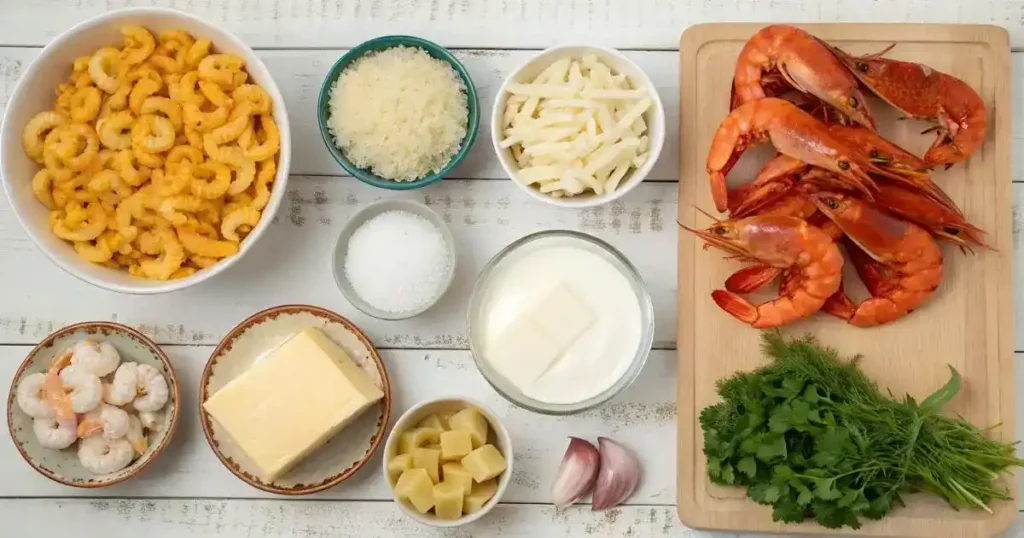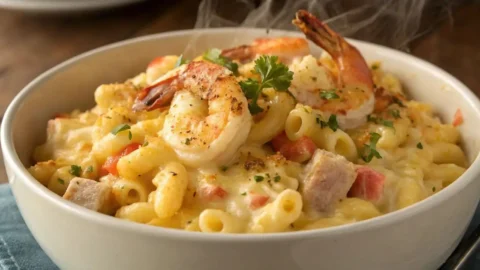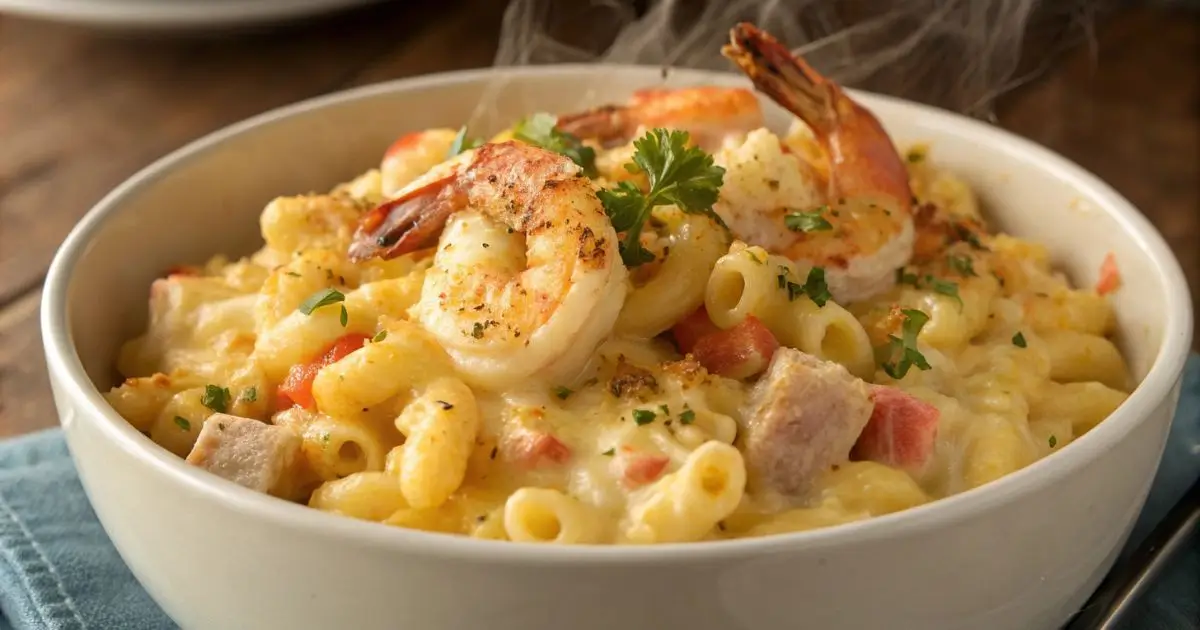The Ultimate Creamy Baked Seafood Mac and Cheese Recipe
introduction
There’s nothing quite like a warm bowl of seafood macaroni and cheese, the ultimate comfort food that blends creamy sauce, tender pasta, and buttery seafood in one dish. This version takes it to another level with layers of rich and decadent flavor, a crisp golden topping, and that signature seafood sweetness.
Whether you’re using shrimp, crab, or lobster, this recipe turns a classic favorite into a restaurant-quality meal right from your kitchen. It’s cozy enough for weeknights but elegant enough for guests, combining home-cooked heart with fine-dining flavor.
If you’ve ever wanted your mac and cheese to taste like it came straight from a chef’s menu, this is the recipe to bookmark.
Table of Contents
Key Benefits of Seafood Macaroni and Cheese
Why settle for ordinary when you can savor a dish that’s both comforting and indulgent? Seafood macaroni and cheese is more than just a meal—it’s an experience. Here’s why this recipe deserves a spot on your dinner table:
- Rich and Creamy Texture: The velvety cheese sauce wraps every bite of pasta in luxurious flavor, creating a dish that feels like pure comfort.
- Elevated with Fresh Seafood: Shrimp, lobster, or crab add a touch of elegance and protein, transforming a classic into a gourmet delight.
- Perfect for Any Occasion: Whether you’re celebrating a special event or cozying up on a weeknight, this recipe strikes the perfect balance between fancy and familiar.
- Easy to Make: Don’t be intimidated! With step-by-step guidance, even novice cooks can master this impressive dish.
- Customizable to Your Taste: Prefer a bit more spice? Want to swap in your favorite seafood?
Ingredients
Creating this decadent seafood macaroni and cheese starts with gathering the right ingredients. Each element plays a crucial role in building the rich, creamy, and flavorful dish you’re about to enjoy. Here’s what you’ll need:
For the Pasta and Seafood:
- 8 ounces elbow macaroni – Classic macaroni works perfectly, but feel free to swap for shells or cavatappi for extra texture.
- 1 cup shrimp, peeled and deveined – Fresh or frozen shrimp adds a tender, slightly sweet bite.
- 1 cup lump crab meat – Opt for fresh or high-quality canned crab for the best flavor.
- 1/2 cup lobster meat (optional) – This adds an indulgent touch, perfect for special occasions.
For the Cheese Sauce:
- 4 tablespoons butter – The base for your roux, lending richness to the sauce.
- 4 tablespoons all-purpose flour – Helps thicken the sauce for that creamy consistency.
- 3 cups whole milk – For a velvety texture, but you can use half-and-half for extra creaminess.
- 1,5 cup shredded sharp cheddar cheese – Bold and tangy, it’s the backbone of the cheese blend.
- 1 cup shredded Gruyère cheese – Adds a nutty, upscale flavor.
- 0.5 cup Parmesan cheese, grated – Brings a salty, umami kick.
For the Topping:
- 1/2 cup panko breadcrumbs – Creates a golden, crispy crust.
- 2 tablespoons melted butter – Helps the breadcrumbs brown beautifully.
- 1 teaspoon paprika – Adds a hint of smokiness and color.
Optional Seasonings:
- 1 teaspoon garlic powder – For a subtle, savory depth.
- 1/2 teaspoon onion powder – Enhances the overall flavor.
- 1/4 teaspoon cayenne pepper – For a touch of heat (optional).

Step-by-Step Instructions
1. Prepare the Pasta
- Fill a large pot with water, add a generous pinch of salt, and bring it to a vigorous boil.
- Prepare the macaroni according to the package instructions, cooking it until it’s tender yet still firm to the bite (al dente).
- Drain the pasta, then toss it with a light drizzle of olive oil to keep it from sticking together while you prep the rest.
2. Cook the Seafood
- Heat 1 tablespoon of butter in a large skillet over medium heat until melted.
- Add your choice of seafood—shrimp, lobster, or crab—and season with a dash of salt, a sprinkle of black pepper, and a hint of smoked paprika.
- Sauté for 3-5 minutes, stirring occasionally, until the seafood is fully cooked and just turns opaque. Remove from the skillet and set aside.
3. Make the Cheese Sauce
- Using the same skillet, melt 4 tablespoons of butter over medium heat.
- Sprinkle in 4 tablespoons of all-purpose flour, whisking constantly to form a smooth roux. Allow the roux to cook for 1-2 minutes to remove any raw flour taste.
- Gradually pour in 3 cups of milk and 1 cup of heavy cream, whisking continuously to prevent lumps.
- Let the mixture simmer gently for 5-7 minutes, stirring frequently, until it thickens into a creamy sauce.
- Reduce the heat to low and stir in 2 cups of shredded cheddar, 1 cup of Gruyère, and ½ cup of Parmesan cheese. Continue stirring until the cheese is completely melted and the sauce has a velvety smooth texture.
4. Combine the Pasta and Sauce
- Return the drained macaroni to the skillet, mixing it thoroughly with the cheese sauce to ensure every piece is coated.
- Gently fold in the cooked seafood, distributing it evenly throughout the pasta mixture.
5. Assemble and Bake
- Preheat your oven to 375°F (190°C).
- Transfer the macaroni and cheese mixture into a greased 9×13-inch baking dish.
- Sprinkle the top with a mixture of panko breadcrumbs and an additional ½ cup of Parmesan cheese to create a crispy, golden crust.
- Bake the dish uncovered for 20-25 minutes, or until it’s bubbling around the edges and lightly browned on top.
6. Garnish and Serve
- Once baked, let the dish rest for 5 minutes before serving.
- Sprinkle freshly chopped parsley or chives over the top for an added burst of color and flavor.
- Serve warm and savor every creamy, seafood-infused bite!
With these steps, you’ll have a seafood macaroni and cheese that’s nothing short of extraordinary. It’s a dish that brings comfort and indulgence to your table, perfect for any occasion!
Mastering the Perfect Ultra-Creamy Cheese Sauce
The secret to any great mac and cheese lies in its sauce. Getting that smooth, creamy finish depends on balancing heat, timing, and proper technique. Follow these steps to master it every time.
Start with the Roux
The roux forms the foundation of your sauce.
- Melt 2 tablespoons of butter over medium heat.
- Whisk in 2 tablespoons of all-purpose flour until it becomes smooth and slightly foamy.
- Cook for 1–2 minutes to remove the raw flour taste — you’ll notice a mild, nutty aroma.
Tip: Don’t let it brown. A light roux keeps the sauce rich and creamy without turning heavy.
Build the Béchamel
Slowly pour in 3 cups of warm milk, whisking the entire time to avoid lumps.
Keep stirring until the sauce thickens enough to coat the back of a spoon.
This creamy base, known as béchamel, is what gives mac and cheese its smooth body.
Add the Cheese
Lower the heat and stir in 3 cups of freshly shredded cheese — a blend of sharp cheddar, Gruyère, and Monterey Jack works best.
Add the cheese slowly, stirring until it melts completely into a silky sauce.
Why Freshly Grated Cheese Matters:
Pre-shredded cheese has anti-caking agents that block even melting and cause a grainy texture.
Always shred cheese by hand for the smoothest result.
Flavor Boosters: Mustard Powder and Nutmeg
Two small ingredients make a huge difference.
- Mustard powder brightens the sauce and balances the richness.
- A pinch of ground nutmeg adds warmth and depth without overpowering the cheese.
These subtle additions turn a good sauce into a standout one with layered flavor.
Common Mistakes to Avoid
- Don’t rush the roux; undercooking leaves a raw flour taste.
- Don’t overheat; boiling milk can make the sauce split.
- Don’t dump all the cheese at once — melt it in batches for a smoother texture.
Once your sauce is glossy and creamy, it’s ready to combine with pasta and seafood.
This step defines the final texture. Take your time and let the sauce come together slowly for that perfect, restaurant-quality finish.
Creative Twists and Easy Variations
This seafood macaroni and cheese is already a showstopper, but with a few tweaks and creative spins, you can make it even more special! Here are some pro tips and variations to help you tailor the recipe to your taste and needs:
1. Upgrade Your Cheese
- Try Smoked Gouda or Gruyère: For an extra layer of flavor, consider swapping in smoked Gouda or Gruyère cheese. These cheeses melt beautifully and add a subtle smokiness that pairs perfectly with the seafood.
- Mix in Cream Cheese: For an ultra-creamy texture, stir in a few tablespoons of cream cheese to the sauce. This will give your dish a rich, velvety feel.
2. Seafood Substitutions
- Salmon or Scallops: Not a fan of shrimp? Try flaking in some cooked salmon or adding tender scallops. These seafood options complement the creamy sauce beautifully.
- Frozen vs. Fresh Seafood: While fresh seafood is always best, frozen seafood works just as well in this recipe. Just make sure to thaw and pat it dry before cooking to avoid excess moisture in the dish.
3. Gluten-Free Options
- Gluten-Free Pasta: Swap out regular pasta for gluten-free macaroni if you need to cater to dietary restrictions. The rest of the recipe remains the same, and the result will still be deliciously creamy.
- Gluten-Free Breadcrumbs: For a crispy topping, use gluten-free panko breadcrumbs. You’ll still get that golden, crunchy crust!
4. Spice It Up
- Add Some Heat: If you like a bit of spice, sprinkle in a pinch of cayenne pepper or a dash of hot sauce when making the cheese sauce. It’ll add a zesty kick that balances out the creamy richness.
- Old Bay Seasoning: For a more classic seafood flavor, try dusting the seafood with Old Bay seasoning before cooking. It enhances the natural sweetness of the seafood while adding a savory twist.
5. Make It a One-Pot Meal
- Skip the Oven: If you want to keep things even simpler, skip the baking step! After mixing the pasta with the sauce and seafood, serve it directly from the skillet for a one-pan, no-fuss meal.
6. Add Fresh Veggies
- Spinach or Peas: For a touch of freshness, stir in some sautéed spinach or frozen peas before baking. These veggies add color, flavor, and a nice contrast to the rich sauce.
Seafood Choices: Cost, Flavor, and Prep Guide
Choosing the right seafood is the key to creating a rich, flavorful seafood mac and cheese. Each type brings its own taste, texture, and price point. Here’s how to decide what fits your dish best.
Lobster Mac and Cheese
- Flavor: Sweet, buttery, and delicate.
- Texture: Tender and slightly firm, it stands out even with a creamy sauce.
- Prep Tip: Steam or boil just until opaque. Undercook slightly since it will finish baking in the oven.
Lobster adds a luxury feel, perfect for special dinners or holidays.
Shrimp Mac and Cheese
- Flavor: Mild and slightly briny, blends smoothly with sharp cheeses.
- Texture: Firm and juicy when cooked right.
- Prep Tip: Sauté until pink, about 1–2 minutes per side. Avoid overcooking, or it turns rubbery.
Shrimp gives a balanced flavor, ideal for weeknight meals that still feel indulgent.
Crab Mac and Cheese
- Flavor: Sweet, salty, and rich, great with Old Bay seasoning.
- Texture: Soft and flaky.
- Prep Tip: If using fresh crab, check for shell pieces. Gently fold it in after the cheese sauce to keep chunks intact.
Crab creates a smooth, buttery taste that complements mild cheeses like Gruyère or Monterey Jack.
Frozen vs. Fresh Seafood
- Frozen: Budget-friendly and convenient. Thaw overnight in the fridge or under cold running water before using.
- Fresh: Best flavor, but pricier and spoils quickly. Buy from a trusted fishmonger.
If you use frozen seafood, pat it dry to prevent excess moisture in your sauce.
Seafood Comparison Chart
| Seafood Type | Flavor Strength | Texture | Best Cheese Pairing | Cooking Tip |
| Lobster | Sweet, buttery | Firm | Sharp cheddar + Gruyère | Slightly undercook before baking |
| Shrimp | Mild, briny | Juicy | White cheddar + Monterey Jack | Quick sear before mixing |
| Crab | Sweet, salty | Soft | Gruyère + Parmesan | Add after the sauce to keep the flakes whole |
For the best balance of flavor and cost, use a mix of shrimp and crab. This combo gives depth, texture, and a restaurant-level taste without overspending.
Serving Suggestions
Now that you’ve created this creamy, decadent seafood macaroni and cheese, it’s time to make the meal even more memorable with the perfect serving ideas. Whether you’re preparing it for a cozy family dinner or impressing guests at a special event, these suggestions will elevate your dish and complete the experience.
- Garlic Bread: The rich, cheesy goodness of the mac and cheese pairs perfectly with the crispy, buttery delight of garlic bread. Serve a few slices on the side to scoop up all that cheesy sauce!
- Side Salad: A fresh, light salad with a tangy vinaigrette balances the richness of the macaroni and cheese. Try a mix of greens, such as arugula or spinach, with cherry tomatoes and a squeeze of lemon for a burst of freshness.
- Wine Pairing: A crisp, refreshing glass of white wine, like Chardonnay or Sauvignon Blanc, complements the seafood and the creamy texture of the dish. If you’re serving this for a special occasion, you can’t go wrong with a chilled bottle!
- Fresh Herbs: Garnish your dish with a sprinkle of fresh parsley, chives, or even a few lemon wedges for an extra pop of flavor and color. A little zest goes a long way in brightening up this indulgent dish.
These simple yet thoughtful additions not only enhance the presentation but also bring out the best in your seafood macaroni and cheese. Your meal is now ready to shine!
Topping Options for the Perfect Crunch
A good topping gives seafood mac and cheese its signature golden crust. The contrast between the creamy sauce and crisp top makes each bite satisfying. Here’s how to create that perfect texture — plus a few tasty variations.
Classic Panko Crust
Panko breadcrumbs are light and airy, giving your mac and cheese a crispy top that stays crunchy after baking.
- Mix 1 cup of panko breadcrumbs with 2 tablespoons of melted butter.
- Sprinkle evenly over the mac and cheese before baking.
- Bake until golden and slightly toasted on top.
Tip: Add a pinch of smoked paprika or garlic powder for extra depth.
Fresh Breadcrumbs
Fresh breadcrumbs create a softer, more homemade crust that absorbs just a bit of sauce underneath.
- Tear day-old bread into small pieces and pulse it in a food processor.
- Toss with melted butter and spread over the dish.
- This topping browns beautifully and adds a rustic, bakery-style texture.
Ritz Cracker Topping
For a buttery, nostalgic crunch, crushed Ritz crackers are a great choice.
- Crush about 15–20 crackers and mix with 2 tablespoons of melted butter.
- Scatter on top before baking.
- The buttery flavor pairs perfectly with lobster and crab versions of this recipe.
Bonus Tip: Mix Ritz crumbs with shredded Parmesan for an extra crisp top and cheesy bite.
Optional Garnishes
Once baked, finish with a sprinkle of fresh parsley, lemon zest, or a dash of Old Bay seasoning. These light touches brighten the rich sauce and make the dish look fresh and inviting.
This topping layer is where your seafood mac and cheese transforms from comfort food to a restaurant-quality dish. Whether you go with panko for crunch or Ritz crackers for richness, it’s the perfect finishing touch.
The Secret to Flawless Leftovers: Perfect Reheating
Seafood mac and cheese tastes best when fresh, but with the right method, your leftovers can stay just as creamy and flavorful. The key is gentle heat, a touch of moisture, and one simple trick most people skip — cream cheese.
How to Store Seafood Mac and Cheese
- Refrigerator: Cool completely before storing. Transfer to an airtight container and refrigerate for up to 3 days.
- Freezer: For longer storage, portion into freezer-safe bags or containers. Keep for up to 2 months.
- Thawing: Move frozen portions to the fridge overnight before reheating. Avoid microwaving from frozen — it can break the sauce.
The Cream Cheese Trick
Add 1 tablespoon of cream cheese per cup of leftover mac and cheese before reheating. This keeps the sauce smooth and rich, replacing moisture lost during cooling. The cream cheese melts evenly and prevents the sauce from separating or drying out.
Reheating Methods
1. Stovetop (Best Method)
- Place leftovers in a saucepan over low heat.
- Add a splash of milk or cream (2 tablespoons per serving).
- Stir gently until creamy and hot.
- Mix in the cream cheese just before serving.
Why it works: Low, slow heat and added fat rebuild the emulsion, keeping the sauce silky.
2. Oven (For Large Portions)
- Preheat to 325°F (160°C).
- Place mac and cheese in a baking dish, cover with foil.
- Add a few spoonfuls of milk or cream to the top before covering.
- Bake for 15–20 minutes, then stir and serve.
Pro tip: For a crispy topping, uncover for the last 5 minutes and sprinkle with breadcrumbs or shredded cheese.
3. Microwave (Quick Fix)
- Transfer a single serving to a microwave-safe bowl.
- Add a spoonful of milk or cream and stir in cream cheese.
- Cover loosely and heat on medium power in 30-second bursts, stirring each time.
- Stop once heated through; do not overheat.
Why medium power? It warms the cheese slowly, preventing clumping.
Can You Freeze It Again After Reheating?
No, avoid refreezing once reheated. Seafood proteins break down further, and the sauce can separate. Store only what you’ll eat within the next few days.
Using these simple steps, your leftover seafood mac and cheese stays creamy, flavorful, and perfectly reheated — never dry or grainy.

Seafood Macaroni and Cheese
Ingredients
For the Pasta and Seafood
- 8 oz elbow macaroni can substitute shells or cavatappi
- 1 cup shrimp peeled and deveined
- 1 cup lump crab meat fresh or canned
- 0.5 cup lobster meat optional, for special occasions
For the Cheese Sauce
- 2 tbsp butter
- 2 tbsp all-purpose flour
- 2 cups whole milk
- 1 cup shredded sharp cheddar cheese
- 0.5 cup shredded Gruyère cheese
- 0.25 cup Parmesan cheese grated
For the Topping
- 0.5 cup panko breadcrumbs
- 2 tbsp melted butter
- 1 tsp paprika
Optional Seasonings
- 1 tsp garlic powder
- 0.5 tsp onion powder
- 0.25 tsp cayenne pepper optional
Instructions
- Step 1: Prepare the PastaBoil the macaroni in salted water until al dente. Drain and toss with olive oil to prevent sticking.
- Step 2: Cook the SeafoodIn a skillet, melt butter and sauté shrimp, lobster, or crab for 3–5 minutes until opaque. Season with salt, pepper, and smoked paprika. Remove and set aside.
- Step 3: Make the Cheese SauceMelt butter, whisk in flour to form a roux, then gradually add milk and cream. Simmer until thickened, then stir in cheeses until smooth and creamy.
- Step 4: Combine Pasta and SauceMix drained pasta with cheese sauce. Gently fold in the cooked seafood until evenly distributed.
- Step 5: Assemble and BakePreheat oven to 375°F (190°C). Transfer mixture to a greased baking dish, top with breadcrumbs and Parmesan. Bake 20–25 minutes until golden and bubbling.
- Step 6: Garnish and ServeLet rest for 5 minutes, then top with fresh parsley or chives. Serve warm.
Notes
Conclusion
This seafood mac and cheese brings the best of both worlds: comfort food you crave and restaurant-quality flavor you’d expect from a five-star kitchen. The creamy sauce, buttery seafood, and crispy topping come together to create something truly rich and decadent.
Serve it for family dinners, holidays, or any night you want a little luxury at home. With each bite, you’ll taste warmth, texture, and a depth of flavor that makes this dish unforgettable.
Once you make it this way, plain mac and cheese just won’t compare.
Troubleshooting and FAQs
Even the best seafood mac and cheese can go wrong if the sauce breaks, the pasta overcooks, or the seafood turns rubbery. Here’s how to fix common issues and master every detail.
How Do I Stop the Sauce from Breaking?
A broken sauce usually means the heat was too high or the cheese wasn’t fully melted before mixing.
Fix:
Keep the stovetop on low to medium heat while adding cheese.
Use freshly shredded cheese — pre-shredded varieties contain starch that can cause clumping.
Stir constantly until smooth before combining with pasta.
If it separates, whisk in a few tablespoons of warm milk or cream until creamy again.
What Kind of Cheese Melts Best?
Smooth melting cheeses like Gruyère, white cheddar, Monterey Jack, and Fontina are perfect.
Tip:
Combine at least two types for balanced flavor and texture.
Add a small pinch of ground nutmeg or Dijon mustard to sharpen the taste and cut through richness.
What Pasta Shape Holds the Sauce Best?
Pasta with ridges or curves traps the creamy sauce beautifully.
Top Picks:
Cavatappi: Holds sauce in every curve, adds chew.
Elbow macaroni: Classic choice, cooks evenly.
Shells: Ideal for chunkier seafood pieces.
Avoid long noodles — they don’t grip the sauce well and can break apart during mixing.
Can I Freeze Mac and Cheese?
Yes, but only before baking for the best texture.
Steps:
Assemble the mac and cheese in a freezer-safe dish (without baking).
Wrap tightly in foil and plastic wrap.
Freeze for up to 2 months.
Bake straight from frozen at 350°F (175°C) for 45–50 minutes, covering for the first 30 minutes.
For baked leftovers, freezing can cause slight texture loss, so reheat gently with extra milk and cream cheese.
How Long Does Seafood Mac and Cheese Last?
Refrigerator: Up to 3 days.
Freezer: Up to 2 months (unbaked).
Always store in an airtight container and label with the date.
Discard if it smells off or becomes watery after thawing.
Why Did My Seafood Turn Rubbery?
Overcooking is the main cause.
Prevent It:
Remember: they continue to cook in the oven’s residual heat.
Slightly undercook shrimp, crab, or lobster before baking.
Have you given our recipe a try ?
There are no reviews yet. Be the first one to write one.
Last Updated on October 27, 2025 by Janelle
- The Ultimate Tiramisu Cheesecake - October 18, 2025
- The Only Cottage Cheese Bread Guide You’ll Ever Need (4 Ways) - October 4, 2025
- The Best Cottage Cheese Protein Pancakes (3 Easy Recipes) - September 16, 2025

